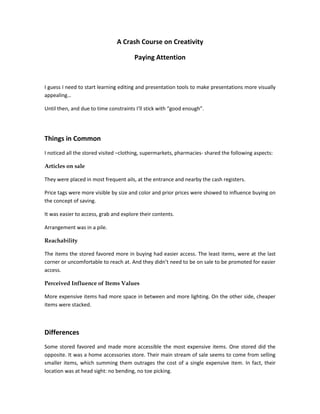
Crash Course on Creativity: Paying Attention to Store Displays
- 1. A Crash Course on Creativity Paying Attention I guess I need to start learning editing and presentation tools to make presentations more visually appealing… Until then, and due to time constraints I’ll stick with “good enough”. Things in Common I noticed all the stored visited –clothing, supermarkets, pharmacies- shared the following aspects: Articles on sale They were placed in most frequent ails, at the entrance and nearby the cash registers. Price tags were more visible by size and color and prior prices were showed to influence buying on the concept of saving. It was easier to access, grab and explore their contents. Arrangement was in a pile. Reachability The items the stored favored more in buying had easier access. The least items, were at the last corner or uncomfortable to reach at. And they didn’t need to be on sale to be promoted for easier access. Perceived Influence of Items Values More expensive items had more space in between and more lighting. On the other side, cheaper items were stacked. Differences Some stored favored and made more accessible the most expensive items. One stored did the opposite. It was a home accessories store. Their main stream of sale seems to come from selling smaller items, which summing them outrages the cost of a single expensive item. In fact, their location was at head sight: no bending, no toe picking.
- 2. Also, this same store, enhanced emotions by settling “look how it would look in your own house this item” with tiny showrooms mingled here and there. On customer throughput time, the stored who generally sold more expensive items, promoted an overall feeling of exploration: the more you see, the more you want to buy. Clutter was also reduced. Ideas Some products attired my attention by their uniqueness and package likeability. Although, they were odd, missing information on how I would use it, or their special traits, stopped me from the intent of buying them. Customer care in Bolivia is deficient, so why even bother asking: they probably didn’t know them either. If I could use a POS (point of sale) that read code bars and showed me a video of the products (story telling) or a description catalog, I would have had more chance of acquiring them. There were stores that used the same color for sale tags and new items. Maybe, color differentiation would have given clearer separation of the two concepts. Big stores needed a roadmap to find appliances and sectors quickly. Only one of them, had customer points with the opportunity to win products or lower prices. Maybe these stores could benefit from campaigns, where customer fidelity plus some random secret items that went bought together would make them cheaper or free. These would change on same time period.
